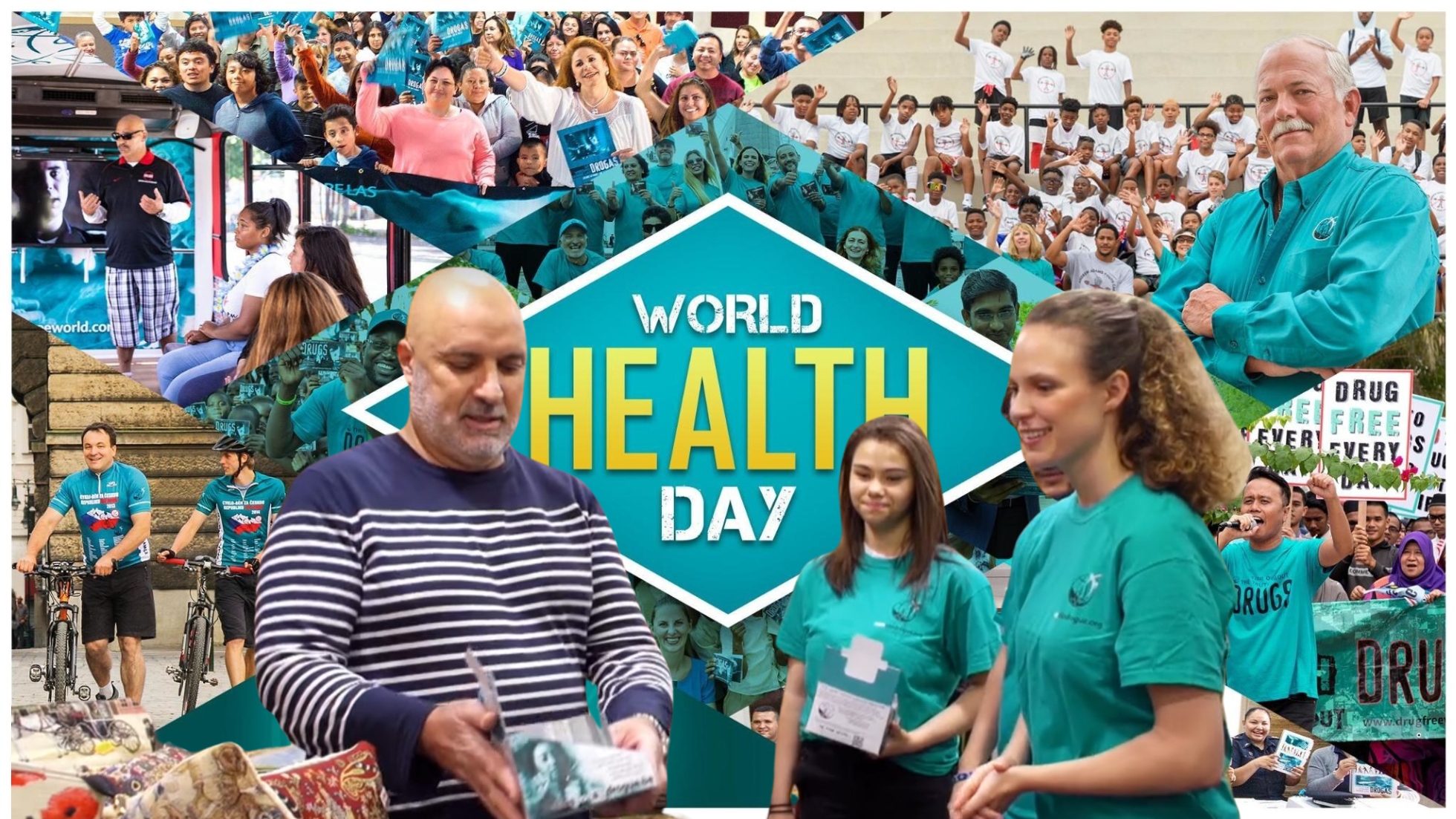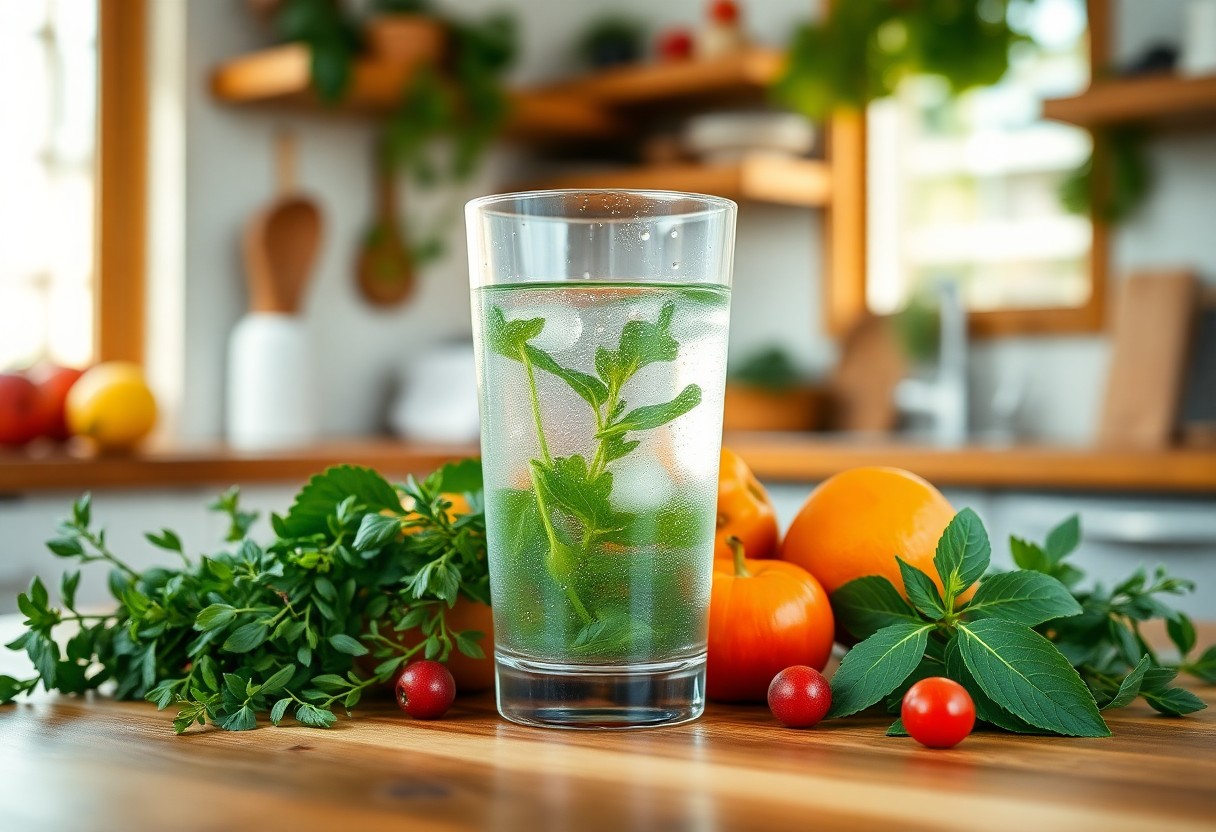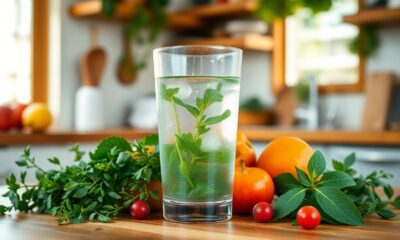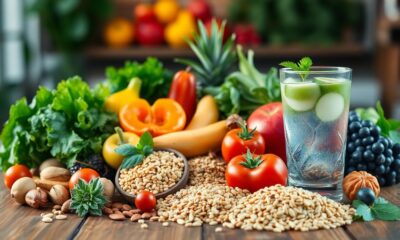Health & Society
World Health Day 2025: Scientology Network Promotes a Drug-Free World Through Education and Awareness

KINGNEWSWIRE / Press release / April 7, 2025 — In celebration of World Health Day, the Scientology Network aired an ambitious all-day television marathon to address one of the most ravaging public health crises of our time: drug abuse. The programming initiative, which ran throughout the day, was aimed at educating viewers about the threat of drugs and promoting prevention efforts through compelling documentaries, public service announcements (PSAs), and inspiring profiles of grassroots activists who are fighting and addiction in their communities.
The marathon “World Health Day Marathon to Shape a Drug-Free Future”, involved the Foundation for a Drug-Free World, the Scientologist-sponsored charity that has brought its evidence-based educational materials to almost 200 countries. As drug overdoses still take lives—especially young adults between the ages of 18–45 according to reports—the campaign emphasized the need for immediate action.(1)
A Crisis Demanding Attention
Based on recent statistics cited during the marathon, almost half of all American teens have tried illegal drugs by the time they finish high school. This risky behavior is largely responsible for the increasing rate of overdose deaths, which continue to be one of the most common causes of death for young adults.
Contributing to the problem are chemical street drugs and prescription medications that are being highly promoted by pharmaceutical companies, both of which are extremely dangerous to naive users.
The Truth About Drugs campaign—the cornerstone of the Foundation’s activities—works to counteract drug use myths by providing clear, factual information. In partnership with schools, community groups, and government agencies, the foundation supplies educators, parents, and activists with the materials to stop drug abuse progression before it starts.
Highlights of the Programming Lineup
The marathon included some major elements:
Voices for Humanity : A TV show that featured people who acted to stem society’s ills, including drug addiction. From teachers introducing drug education programs into classrooms to volunteers passing out informational brochures on street corners, these portraits recognized ordinary citizens who were doing extraordinary things. This included the Vice President of Foundation for Drug Free Europe Julie Delvaux, who has her own episode about the work she is doing in Belgium and who also organizes specialized conferences at the UNODC.
Public Service Announcements (PSAs) : Brief but powerful messages emphasized specific drugs such as marijuana, opioids, and synthetic drugs. The PSAs addressed not just the physical cost of addiction but also its wider social cost, including damaged relationships and missed opportunities.
Documentary Feature: “The Truth About Drugs” : Showcasing an uncompromising look at the realities of drug abuse, the documentary explored the science of addiction, personal tales of reformed addicts, and revelations concerning extensive marketing campaigns that normalize harmful behavior. It served as a wake-up call for those viewers who had no idea how widespread the problem was.
A Legacy of Social Betterment Founded upon Visionary Leadership
Established by writer and philanthropist L. Ron Hubbard, the Church of Scientology has been dedicated to solving the issues of society through its international Social Betterment programs for decades. These initiatives, comprising anti-drug abuse, anti-crime, anti-illiteracy, and anti-human rights abuse campaigns, demonstrate Hubbard’s aspiration to empower individuals and make communities more resilient. The Church has garnered dozens of awards and acknowledgments globally for its community service throughout the years.
These programs, especially the Foundation for a Drug-Free World, have been hailed by governments, NGOs, and civic groups for their effectiveness and continue to save lives through education and activism. Having reached millions of lives through these programs, the Church is undeterred in its commitment to continuing Hubbard’s legacy of compassion and service.
Reaching International Audiences
Since it debuted on March 12, 2018, the Scientology Network has been a platform for presenting a wide range of views and highlighting humanitarian endeavors in keeping with the Church’s mission. Seen in more than 240 nations and territories on six continents, the network airs to millions of households on DIRECTV, streaming platforms, and mobile apps. Its cutting-edge storytelling has garnered over 125 industry awards, attesting to its dedication to programming excellence. For this World Health Day observance, the network utilized its worldwide audience to share the message of prevention and recovery. Airing live from the Scientology Media Productions’ cutting-edge studios in Los Angeles, the marathon began at 8 a.m. ET and ran throughout the day for optimal viewing accessibility across the globe.
While the marathon constituted a day of focused activism, its purpose extends far beyond April 7. By empowering communities with information and materials, the Foundation for a Drug-Free World is striving to create lasting change—a world where fewer lives are devastated by addiction and more can thrive independent of dependency on illicit drugs.
Today, on this World Health Day, the Scientology Network demonstrated how life-altering that power is when applied to the greater good. To view the complete schedule or watch on-demand content from the marathon, go to Scientology.tv/schedule. World Health Day for this year is behind us, but the conversation sparked by the Scientology Network programming continues to reverberate. As communities around the world grapple with the devastating effects of drug abuse, campaigns like these remind us that hope lies in education, collaboration and unwavering determination to forge a healthier tomorrow for all.
Scientology Network debuted on March 12, 2018, launched by David Miscavige, ecclesiastical leader of the Scientology religion. Since then, Scientology Network has been viewed in over 240 countries and territories worldwide in 17 languages.
Health & Society
Harnessing the Sun – The Surprising Health Benefits of Vitamin D

It’s well-documented that Vitamin D, often referred to as the “sunshine vitamin,” plays a vital role in overall health. They may not realize that this important nutrient helps regulate calcium and phosphorus, contributing to healthy bones and teeth. Furthermore, Vitamin D can bolster the immune system, which is particularly important during flu season. However, a deficiency in Vitamin D can lead to serious health concerns, including osteoporosis and increased risk of chronic diseases. This blog post explores the myriad benefits of Vitamin D, emphasizing why he, she, or they should prioritize safe sun exposure.
Key Takeaways:
- Vitamin D plays a significant role in bone health by enhancing calcium absorption, reducing the risk of fractures and osteoporosis.
- Research suggests that adequate levels of Vitamin D may improve mood and help in the prevention of depression and anxiety disorders.
- The vitamin is linked to a stronger immune system, potentially lowering the risk of infections and autoimmune diseases.
- Sun exposure is a natural source of Vitamin D, yet many individuals may require supplementation, especially in regions with limited sunlight.
- In addition to sunlight, dietary sources such as fatty fish, fortified foods, and egg yolks can contribute to maintaining optimal Vitamin D levels.
Understanding Vitamin D
A comprehensive understanding of Vitamin D is imperative for appreciating its myriad health benefits. Often referred to as the “sunshine vitamin,” it is a fat-soluble vitamin that plays a vital role in various bodily functions, including immune function, bone health, and mood regulation. Despite its importance, many individuals do not receive sufficient levels of Vitamin D, leading to a range of health issues. This chapter explores the sources, functions, and significance of Vitamin D in maintaining overall health.
Sources of Vitamin D
Beside sunlight, Vitamin D can be obtained from several dietary sources, such as fatty fish, fortified dairy products, and egg yolks. For those who may struggle to get enough sunlight exposure, supplements are also available to help maintain optimal levels. Understanding these sources is vital for ensuring adequate Vitamin D intake, particularly in areas with limited sunlight or during winter months.
How Vitamin D Functions in the Body
Before delving into the functions of Vitamin D, it is imperative to note that this vitamin operates through numerous mechanisms. It assists in the absorption of calcium and phosphorus, which are vital for strong bones and teeth. Additionally, they may help regulate the immune response, thereby reducing the risk of chronic diseases. Vitamin D also influences mood and may play a role in the prevention of depression and other mood disorders.
Sources of Vitamin D are key to understanding how it functions in the body. When the skin is exposed to sunlight, it synthesizes Vitamin D from cholesterol. This active form then helps the body absorb imperative minerals such as calcium and phosphorus, thereby promoting strong bone health. Additionally, sufficient levels of Vitamin D may support the immune system by modulating the body’s inflammatory response. Research indicates that Vitamin D may also be linked to improved mood regulation, potentially reducing the risk of mental health issues. Maintaining adequate Vitamin D levels is, therefore, of utmost importance for overall well-being.
Health Benefits of Vitamin D
Even though many people associate vitamin D primarily with bone health, it packs a robust array of health benefits. This imperative nutrient not only aids in the development and maintenance of strong bones but also supports muscle function, regulates mood, and enhances overall well-being. By obtaining adequate amounts of vitamin D, individuals can improve their health across various systems in the body.
Bone Health and Calcium Regulation
An adequate intake of vitamin D is vital for maintaining bone health and regulating calcium levels in the body. It enhances calcium absorption in the intestines, ensuring that bones remain strong and dense. This nutrient works synergistically with calcium, minimizing the risk of fractures and conditions like osteoporosis, especially in older adults.
Immune System Support
Behind its role in bone health, vitamin D also plays a dynamic role in supporting the immune system. This nutrient helps modulate the body’s defense mechanisms, aiding in the prevention of infections and autoimmune diseases.
In addition to its impact on overall immunity, vitamin D has been found to play a role in reducing the risk of respiratory infections and certain diseases. Insufficient levels of vitamin D may lead to a weakened immune response, making individuals more vulnerable to infections and illnesses. Studies suggest that maintaining optimal vitamin D levels could lead to improved health outcomes and strength against chronic conditions, highlighting its importance in a balanced diet and lifestyle.
Vitamin D and Mental Well-being
Not only does Vitamin D play a vital role in bone health, but it also significantly impacts mental well-being. Many studies indicate that sufficient levels of Vitamin D are associated with a lower risk of mental health disorders. Individuals who maintain adequate Vitamin D levels may experience enhanced emotional resilience and improved overall mood.
Impact on Mood and Depression
Depression is often linked to Vitamin D deficiency, with research suggesting that individuals with low levels may be at a higher risk for developing depressive symptoms. Addressing Vitamin D insufficiency can be an effective part of comprehensive treatment strategies, contributing to an improved outlook on life and reduced feelings of sadness.
Cognitive Function and Memory
Above all, Vitamin D’s role in cognitive function and memory is gaining recognition. Studies show that low Vitamin D levels can impair cognitive abilities and memory retention, potentially increasing the risk of cognitive decline.
Due to the crucial connection between Vitamin D and brain health, individuals with adequate Vitamin D levels often experience enhanced cognitive performance and improved memory. Research indicates that Vitamin D receptor activation in the brain may support learning processes and neuroprotection. Insufficient sunlight exposure, particularly in older populations, can elevate the risk of memory impairment and cognitive disorders. Ensuring sufficient Vitamin D intake may therefore be a strategy for promoting healthy cognitive aging and maintaining optimal brain function.
The Role of Sun Exposure
Many individuals underestimate the importance of sun exposure in achieving optimal health. The sun is a natural source of vitamin D, which plays a vital role in bone health, immune function, and mood regulation. Direct sunlight triggers the skin to synthesize vitamin D, effectively making it one of the most efficient ways to enhance overall well-being. Without adequate sun exposure, people may experience deficiencies that can lead to serious health concerns.
Safe Sun Practices
An important aspect of enjoying the benefits of sunlight is adopting safe sun practices. Individuals should aim for limited exposure during peak hours and be proactive about using sunscreen with a high SPF to prevent skin damage. Additionally, wearing protective clothing and seeking shade can provide an effective balance between obtaining vitamin D and minimizing the risk of skin cancer.
Geographic and Seasonal Considerations
Across the globe, sun exposure varies significantly based on geographic location and seasonal changes. Those living in higher latitudes or regions with prolonged winter months may find it more challenging to obtain sufficient vitamin D from sunlight alone. In contrast, individuals in tropical or subtropical areas often have more consistent sun exposure throughout the year, enabling them to produce vitamin D effectively. Understanding these factors is key for individuals aiming to maintain adequate vitamin D levels.
It is important for individuals to consider their unique circumstances related to sun exposure. In areas with limited sunlight during winter, they may need to seek alternative sources of vitamin D, such as supplements or fortified foods. Conversely, those living in sunnier regions must still be cautious about the dangerous effects of overexposure, which can lead to skin cancers and premature aging. By incorporating knowledge about geographic and seasonal variations, individuals can make informed decisions to ensure they are receiving sufficient vitamin D while also protecting their skin health.
Vitamin D Deficiency
To understand the impact of vitamin D deficiency, it is important to recognize that inadequate levels can lead to a variety of health issues. Factors such as limited sun exposure, certain medical conditions, and dietary restrictions can all contribute to a deficiency. It affects bone health, immune function, and may even link to mood disorders. Individuals should be vigilant about their vitamin D intake, especially those living in regions with less sunlight.
Symptoms and Risks
For individuals with vitamin D deficiency, symptoms may include fatigue, muscle weakness, and bone pain. Long-term deficiency can increase the risk of osteoporosis, fractures, and even contribute to chronic diseases. Awareness of these symptoms and their associated risks is imperative for prompt intervention.
Testing and Diagnosis
Above all, diagnosing vitamin D deficiency typically involves a simple blood test that measures the levels of 25-hydroxyvitamin D in the body. This test is considered the best indicator of vitamin D status. If levels fall below the recognized threshold, healthcare professionals may recommend supplements or dietary changes to restore balance.
At a standard medical appointment, healthcare providers often discuss signs and issues related to vitamin D deficiency. Individuals experiencing symptoms are encouraged to undergo blood testing for 25-hydroxyvitamin D levels. If deficiency is detected, they may face significant health challenges, including weakened immune responses and increased risk of chronic conditions. Addressing deficiencies early can promote overall well-being, encouraging healthcare providers to regularly monitor vitamin D levels, especially in at-risk populations.
Dietary Sources and Supplements
Despite obtaining vitamin D from sunlight, many individuals struggle to meet their needs through natural sources alone. Dietary sources and supplements can bridge these gaps effectively. He or she can incorporate vitamin D-rich foods into their diet or consider supplementation, especially during the winter months or in low-sunlight regions. Consulting with a healthcare provider is advisable to determine individual requirements.
Foods Rich in Vitamin D
Foods that are rich in vitamin D include fatty fish like salmon, mackerel, and sardines, as well as cod liver oil. Fortified foods such as milk, orange juice, and cereals also provide significant amounts of this imperative nutrient. Egg yolks and certain mushrooms treated with UV light can contribute to dietary intake. Incorporating these foods can help maintain adequate levels of vitamin D.
Choosing the Right Supplements
Rich in vitamin D, supplements can be a convenient alternative for those unable to get sufficient amounts through diet alone. He or she should look for products containing cholecalciferol (D3), which is generally more effective than ergocalciferol (D2) at raising blood levels of the vitamin. It’s important to avoid excessive doses as they can lead to toxicity, causing elevated blood calcium levels and other health issues. Evaluating one’s dietary intake and consulting a healthcare professional can help determine the appropriate dosage.
Supplements come in various forms such as soft gels, capsules, and gummies. They offer an easy way to increase vitamin D intake, particularly for individuals with dietary restrictions or those living in less sunny climates. While choosing supplements, he or she should prioritize reputable brands to ensure quality. It’s notable that vitamin D can interact with certain medications, so consulting a healthcare provider to review any potential drug interactions is advisable. Following a well-rounded approach, combining diet and supplements, can significantly enhance overall vitamin D levels.
Summing up
With this in mind, it becomes clear that harnessing the sun for its vitamin D benefits can significantly enhance health and well-being. They should consider integrating safe sun exposure into their routines, alongside dietary sources and supplements when needed. He or she can promote better bone health, support immune function, and improve mood through adequate vitamin D levels. By understanding the importance of sunlight, individuals can take proactive steps toward achieving a healthier lifestyle and improving overall quality of life.
FAQ
Q: What is Vitamin D and how is it produced in our bodies?
A: Vitamin D is a fat-soluble vitamin that plays an imperative role in various bodily functions. The body produces Vitamin D when the skin is exposed to sunlight, specifically ultraviolet B (UVB) rays. When UVB rays penetrate the skin, they convert a cholesterol derivative in the skin into Vitamin D3, which is then transformed into its active form by the liver and kidneys.
Q: What are the main health benefits of Vitamin D?
A: Vitamin D offers multiple health benefits, including supporting bone health by enhancing calcium absorption, boosting immune function, and potentially reducing the risk of certain chronic diseases such as heart disease and diabetes. It may also play a role in regulating mood and warding off depression, particularly in the winter months when sunlight exposure is limited.
Q: How much Vitamin D do I need, and how can I ensure adequate levels?
A: The recommended dietary allowance (RDA) for Vitamin D varies by age, sex, and life stage. Generally, adults need about 600 to 800 IU (International Units) per day. You can ensure adequate levels by getting direct sunlight exposure for about 15 to 30 minutes several times a week, depending on skin type, geographical location, and time of year. Additionally, you can consume Vitamin D-rich foods like fatty fish, fortified dairy products, and egg yolks, or consider taking supplements if necessary.
Q: Are there any risks associated with Vitamin D supplementation?
A: While Vitamin D is imperative for health, excessive supplementation can lead to toxicity, which may cause health issues such as hypercalcemia (elevated levels of calcium in the blood). Symptoms of toxicity can include nausea, vomiting, weakness, and kidney problems. It’s important to consult a healthcare provider before starting any supplementation and to have your Vitamin D levels checked periodically to ensure they stay within a healthy range.
Q: Can I get enough Vitamin D during the winter or in regions with limited sunlight?
A: It can be challenging to get sufficient Vitamin D during the winter months or in areas with limited sunlight. During such times, the UV rays needed for Vitamin D production are often insufficient. To compensate, individuals living in these areas may need to rely more on dietary sources of Vitamin D and consider supplementation to maintain adequate levels. Consulting a healthcare professional can help determine the best approach for your specific circumstances.
Health & Society
Eat the Rainbow – Why Colorful Produce Is Key to Optimal Health

Rainbow-hued fruits and vegetables offer more than just visual appeal; they are crucial for achieving optimal health. He, she, and they can benefit from incorporating a variety of colorful produce into their diets to ensure they receive a wide range of vitamins, minerals, and antioxidants. Each color represents different nutrients that support bodily functions, fight disease, and boost overall well-being. By choosing to “eat the rainbow,” individuals can enhance their immune systems and reduce the risk of chronic illnesses, making vibrant produce a key player in a healthy lifestyle.
Key Takeaways:
- Colorful produce is packed with a variety of vitamins, minerals, and antioxidants that support overall health and immune function.
- Different colors in fruits and vegetables indicate the presence of unique phytonutrients, which offer various health benefits and protection against diseases.
- Incorporating a wide range of colorful foods into your diet can improve digestion, skin health, and even mood by providing crucial nutrients.
- Eating the rainbow encourages a balanced diet, making meal preparation more exciting and visually appealing, which can lead to healthier eating habits.
- Variety in color helps ensure a broad spectrum of nutrients, making it easier to meet daily recommended intake of fruits and vegetables.
The Science Behind Colorful Produce
The vibrant colors of fruits and vegetables are not just visually appealing; they signify the presence of various nutrients necessary for health. Each color provides unique health benefits derived from specific compounds, including vitamins, minerals, and phytochemicals. As she incorporates a variety of colorful produce into their diet, they can tap into the powerful effects these nutrients have on their overall well-being, contributing to optimal health.
Phytochemicals and Their Benefits
The diversity of colorful produce is rich in phytochemicals, which are plant-derived compounds known to promote health. These compounds can help reduce the risk of chronic diseases and enhance overall health. For instance, carotenoids found in orange and yellow fruits and vegetables support eye health, while anthocyanins in blue and purple produce have been linked to cardiovascular benefits. Thus, they give strong attention to including a range of colors in their meals.
Antioxidants and Immune Support
Benefits of consuming colorful produce extend beyond vitamins and minerals, particularly in relation to antioxidants and the immune system.
A variety of colorful fruits and vegetables contain a wealth of antioxidants that play a pivotal role in protecting the body from oxidative stress. This stress contributes to numerous chronic diseases and accelerated aging. By incorporating these antioxidant-rich foods, she supports their immune system and enhances overall health. Foods like berries, citrus fruits, and leafy greens deliver necessary vitamins such as vitamin C and E, which are known to bolster immunity. Thus, they find that a colorful plate is not only aesthetically pleasing but integral in maintaining vitality and defending against illness.
Nutrient Profiles of Different Colors
There’s a wealth of health benefits hidden in the various colors of fruits and vegetables, each offering unique nutrient profiles that contribute to overall well-being. By consuming a diverse array of colorful produce, individuals can ensure they receive a broad spectrum of vitamins, minerals, antioxidants, and phytonutrients that are necessary for maintaining optimal health.
Red and Pink Produce
To enjoy the benefits of red and pink produce, he should incorporate items like tomatoes, strawberries, and watermelon into his diet. These colorful foods are rich in lycopene and anthocyanins, which have been linked to reduced risks of heart disease and certain cancers.
Orange and Yellow Produce
Nutrient-dense orange and yellow produce, such as carrots and oranges, is loaded with vitamin C and beta-carotene, which are necessary for healthy immune function and vision. These vibrant foods not only provide energy but also support skin health.
Even more, these colors signal high levels of antioxidants, which help combat oxidative stress in the body. Incorporating more of these fruits and vegetables can enhance overall health and vitality, making them a must-have in any balanced diet.
Green Vegetables
Pink vegetables like kale and broccoli are instrumental in promoting health through their rich content of fiber and necessary nutrients such as vitamin K and folate. These greens help to support digestive health and are beneficial for blood clotting and energy levels.
Yellow castle also highlights the importance of a green diet, as these vegetables are linked to improved heart health and weight management. He should aim to fill half his plate with green produce to reap the maximum benefits.
Blue and Purple Foods
Blue foods, including blueberries and eggplant, offer powerful antioxidant properties thanks to compounds like anthocyanins. These phytonutrients provide anti-inflammatory benefits and contribute to brain health.
A strong emphasis on blue and purple foods in one’s diet may lead to improved cognitive function and reduced risks of chronic diseases. Incorporating these vibrant foods can significantly enhance one’s health journey and overall wellness.
The Importance of a Balanced Diet
Once again, a balanced diet plays a pivotal role in maintaining overall health and well-being. It provides necessary nutrients that the body requires for optimal functioning. Incorporating a variety of food groups ensures that individuals receive the vitamins, minerals, and fiber necessary to support their immune system, improve digestion, and reduce the risk of chronic diseases. By focusing on diverse and colorful produce, individuals can achieve a more comprehensive nutrient profile and promote better health outcomes.
Creating a Colorful Plate
About incorporating a colorful array of fruits and vegetables into meals, individuals can greatly enhance the nutritional value of their diet. Each color represents different beneficial compounds and antioxidants that contribute to health. For instance, orange and yellow foods like carrots and bell peppers are rich in vitamins A and C, while dark leafy greens offer necessary iron and calcium. By aiming for a rainbow on their plates, they not only improve their health but also make their meals visually appealing.
Seasonal and Local Produce Choices
Seasonal produce options allow individuals to enjoy fruits and vegetables at their peak flavor and nutritional value. By opting for local choices, they also support community agriculture and reduce their carbon footprint, benefiting both their health and the environment.
Importance of seasonal and local produce is evident in both nutrition and sustainability. When she chooses to buy locally sourced fruits and vegetables, she often accesses fresher options packed with flavor and nutrients. Seasonal items are generally more affordable and can also encourage a varied diet, as they promote the consumption of different foods throughout the year. Additionally, supporting local farmers contributes to a sustainable food system that reduces transportation-related emissions and strengthens the local economy.
Cooking Methods to Preserve Nutrients
To maximize the nutrient content of colorful produce, individuals should explore cooking methods that retain their health benefits. Techniques such as steaming, blanching, and sautéing at lower temperatures can help minimize nutrient loss while still enhancing flavors. It’s vital to avoid overcooking, as this can lead to a significant decrease in vital vitamins and minerals. Choosing the right method allows for the vibrant colors and textures of fruits and vegetables to shine while delivering optimum nutrition.
Raw vs. Cooked Produce
Behind the debate of raw versus cooked produce lies the understanding that both forms can offer distinct health benefits. Raw fruits and vegetables contain enzymes and some vitamins that may be reduced during cooking. However, cooking can enhance the bioavailability of important nutrients, such as lycopene in tomatoes and beta-carotene in carrots. Therefore, a balanced approach that incorporates both raw and cooked options can provide a comprehensive array of nutrients vital for optimal health.
Creative Cooking Techniques
Across various culinary cultures, innovative cooking techniques can transform fruits and vegetables while maintaining their nutritional value. Methods such as spiralizing, roasting, and fermenting not only add diverse textures and flavors but also encourage individuals to consume a wider variety of produce. By embracing these creative approaches, they can enjoy meals that are visually appealing and packed with vital nutrients.
Indeed, the exploration of creative cooking techniques opens the door to numerous possibilities in the kitchen. Methods like roasting enhance the natural sweetness of vegetables, making them more enticing while still preserving vitamins when done correctly. Fermenting produces beneficial probiotics that can promote gut health and increase nutrient absorption. Likewise, techniques such as spiralizing not only present a fun, visually stimulating way to enjoy vegetables but also encourage greater vegetable consumption. By diversifying cooking methods, they can create exciting meals that are both nutritious and satisfying.
Overcoming Barriers to Eating the Rainbow
Your journey to a more colorful plate can be hindered by various obstacles, from budget constraints to time limitations. Identifying these barriers is the first step toward conquering them. He or she may need to explore creative solutions that allow them to incorporate a wide range of vibrant fruits and vegetables into their daily meals, ensuring they reap the nutritional benefits of diverse produce.
Budget-Friendly Options
Around the world, fresh produce can sometimes seem pricey. However, individuals can adopt smart strategies to enjoy the health benefits of colorful foods without breaking the bank. They can look for local farmers’ markets, buy in-season fruits and vegetables, or even consider frozen options, which can offer great value.
- Buy in bulk for savings on frequently used items.
- Opt for seasonal produce to reduce costs.
- Explore local farmers’ markets for fresh deals.
Perceiving creative ways to include a variety of produce can lead to both savings and health improvements.
Time-Saving Preparation Tips
By implementing some efficient preparation methods, she or he can easily add more variety to their meals. Prepping ingredients in advance, such as washing and chopping vegetables or making large batches of sauces, can drastically cut down on cooking time during the week. Quick cooking methods, like steaming or stir-frying, can also maintain nutrient integrity while saving precious time.
- Chop veggies in advance for quick access.
- Batch cook meals to enjoy throughout the week.
- Utilize frozen fruits and vegetables for convenience.
Even simple practices can transform mealtime. They can help maximize nutritional intake while minimizing effort. Perceiving the value in pre-prepared foods can turn the challenge of eating the rainbow into a seamless and enjoyable experience.
To wrap up
Drawing together the insights on colorful produce, one can see that incorporating a variety of fruits and vegetables into their diet significantly enhances nutritional intake. They not only provide important vitamins and minerals but also offer diverse antioxidants and phytochemicals beneficial for health. By encouraging individuals to embrace a spectrum of colors on their plates, they are empowered to improve overall wellness and vitality. Making mindful choices about the types of produce they consume sets the stage for a healthier lifestyle that can lead to long-term benefits.
FAQ
Q: What does “Eat the Rainbow” mean in relation to fruits and vegetables?
A: “Eat the Rainbow” is a phrase that encourages individuals to consume a variety of colorful fruits and vegetables. Each color in produce typically represents different vitamins, minerals, and antioxidants, which contribute to overall health. A diverse intake of colorful produce helps ensure that your body receives a wide range of nutrients important for various bodily functions.
Q: Why are colorful fruits and vegetables better for health compared to less colorful options?
A: Colorful fruits and vegetables are often rich in antioxidants and phytochemicals that provide health benefits. For example, red vegetables like tomatoes and red peppers are high in lycopene, which supports heart health, while dark green leafy vegetables like kale are packed with vitamins A, C, and K. Eating a variety of colors ensures that you obtain a spectrum of health benefits, which may not be available in paler produce.
Q: How can I incorporate more colorful produce into my diet?
A: You can increase your intake of colorful produce by adding fruits and vegetables to every meal. Consider starting your day with a fruit smoothie that includes berries, spinach, and bananas, or add a vibrant salad for lunch filled with mixed greens, bell peppers, and carrots. Aim to have at least three different colors on your plate at each meal to diversify your nutrient intake and make meals visually appealing.
Q: Are there any specific health benefits associated with certain colors of produce?
A: Yes, different colors in produce correlate with specific health benefits. For instance, orange and yellow foods, like carrots and sweet potatoes, are high in beta-carotene which is important for eye health. Purple vegetables, such as eggplant and purple cabbage, are rich in anthocyanins that promote healthy aging and reduce inflammation. By eating a range of colors, you can tap into these varied benefits.
Q: Is it better to eat fresh, frozen, or canned colorful produce for optimal health?
A: Fresh produce is typically preferred for its taste and texture, but frozen fruits and vegetables can be just as nutritious as they are usually picked and flash-frozen at peak ripeness, preserving their vitamins. Canned produce can be convenient and have a long shelf life, however, it’s important to choose options without added sugars or high sodium. Including a mix of fresh, frozen, and canned can ensure you have access to colorful produce year-round.
Health & Society
Hydration Hacks – The Underrated Role of Water in Natural Healing

Hydration plays a vital role in maintaining overall health and promoting natural healing processes. He or she might not realize that inadequate water intake can lead to severe dehydration, impacting both physical and mental performance. They should be aware that water aids in digestion, nutrient absorption, and toxin elimination, making it vital for recovery from illnesses. Furthermore, incorporating simple hydration hacks can enhance their wellbeing, as water helps to reduce inflammation and improve skin health. By understanding the powerful benefits of water, individuals can leverage hydration as a fundamental tool in their healing journey.
Key Takeaways:
- Water serves as a foundational element in detoxification, helping to eliminate toxins from the body more effectively.
- Staying adequately hydrated enhances overall digestion and nutrient absorption, promoting better health outcomes.
- Proper hydration can improve skin health, reducing dryness and supporting a natural glow.
- Drinking water before and after meals may assist in weight management by curbing hunger and preventing overeating.
- Incorporating hydrating foods, such as fruits and vegetables, can contribute significantly to daily water intake.
The Science of Hydration
As individuals seek to improve their health, understanding the role of hydration becomes crucial. Adequate water intake not only supports daily functions but also fosters natural healing. Scientific research has demonstrated how hydration impacts various bodily systems, from digestion to cognitive function, highlighting the profound influence of water on overall well-being.
Understanding Body Water Composition
Water constitutes about 60% of the human body, varying by age, gender, and body composition. This crucial fluid plays a vital role in transporting nutrients, regulating temperature, and facilitating metabolic processes. Maintaining an optimal balance of water is crucial for bodily functions to perform efficiently.
The Physiological Benefits of Staying Hydrated
Against the backdrop of modern lifestyles, individuals often overlook the significance of hydration, yet it is paramount for optimal health.
In fact, staying adequately hydrated leads to enhanced cognitive performance, improved mood, and better physical endurance. Dehydration can result in fatigue, diminished concentration, and severe complications such as kidney stones. On the other hand, sufficient water intake ensures the body functions effectively, supports digestion, and enhances nutrient absorption. The positive impacts of hydration extend beyond the physical realm, contributing to mental clarity and overall emotional stability, showcasing the profound connection between water and natural healing.
Water and the Immune System
Clearly, hydration plays a vital role in supporting the immune system. Sufficient water intake ensures optimal circulation of blood and lymphatic fluids, which transport important nutrients and immune cells throughout the body. A well-hydrated individual is less likely to experience fatigue and has a better chance of effectively fighting off infections, making water a key player in maintaining overall health.
Enhancing Immune Function
About 70% of the immune system is located in the gut, where hydration aids in digestion and nutrient absorption. Adequate water intake helps maintain the mucosal lining of the gastrointestinal tract, enhancing the body’s defenses against pathogens. Staying hydrated can lead to a more robust immune response and a decreased risk of illness.
Water’s Role in Detoxification
Along with supporting immune function, water is instrumental in the body’s detoxification processes. Proper hydration assists the kidneys in filtering out waste products and toxins from the bloodstream. This process is vital for preventing the buildup of harmful substances that can compromise overall health.
Understanding how water aids in detoxification reveals its significant impact on health. When an individual remains well-hydrated, their body effectively flushes out toxins through sweat, urine, and stool. Insufficient water intake can lead to dehydration, hindering the kidneys’ ability to eliminate waste, which may result in increased levels of harmful substances in the body. Maintaining proper hydration supports optimal liver function, further enhancing detoxification and promoting overall well-being. Therefore, ensuring adequate water intake is important for those seeking to maintain their health and support their body’s natural cleansing mechanisms.
Hydration and Mental Clarity
Once again, the importance of hydration extends beyond physical health, playing a vital role in mental clarity. When individuals maintain adequate fluid intake, they often experience improved focus, sharper memory, and heightened cognitive function. This demonstrates that the simplest resource—water—can significantly enhance mental performance, helping she, he, or they navigate daily challenges with greater ease.
Effects on Cognitive Function
Clarity of thought improves significantly with proper hydration. Research indicates that even mild dehydration can lead to difficulties in attention, memory, and complex tasks. When he or she prioritizes hydration, they are more likely to perform optimally in mentally demanding situations, fostering a sense of accomplishment and efficiency in their daily responsibilities.
Hydration’s Impact on Mood and Stress
Clarity arises not only in cognitive function but also in emotional well-being. Proper hydration can play a vital part in managing mood and reducing stress levels. When she stays hydrated, they often experience fewer mood swings and a calmer demeanor, which can contribute to overall emotional stability.
Considering the relationship between hydration and emotional health, it becomes evident that inadequate fluid intake can lead to increased feelings of anxiety and depression. Jane and John, for example, may often find that when they are dehydrated, they feel overwhelmed by stress. Conversely, by ensuring they drink enough water, they may notice a noticeable boost in their mood and a reduction in feelings of irritability. The positive effects of hydration, therefore, extend well into mental health, making it a vital aspect of holistic healing practices.
Practical Hydration Hacks
Keep hydration simple by integrating water into daily habits. She can carry a reusable water bottle, set reminders on her phone, or incorporate water-rich foods, like fruits and vegetables, into her meals. Additionally, they might consider infusing their water with herbs or fruits to enhance the flavor, making the experience more enjoyable and encouraging consistent consumption. These small changes can significantly increase overall water intake and promote better health.
Creative Ways to Increase Water Intake
Beside the traditional methods, individuals can explore creative strategies to boost their water consumption. She might try herbal teas or homemade smoothies as a refreshing alternative. Even adding a splash of citrus to her water can not only improve taste but also provide a vitamin boost, making hydration a more appealing part of her daily routine.
Hydration Tracking Tools and Techniques
Among the various strategies, utilizing tracking tools can help monitor water intake effectively. He can use mobile apps designed for this purpose that send alerts and log daily consumption. Additionally, they may find that visual cues, such as marking water levels on their bottle or using a chart, can also motivate them to stay on track.
In fact, tracking water intake can be a game changer for maintaining proper hydration levels. Many apps not only log daily consumption but also generate reports that help her analyze patterns and adjust her habits accordingly. They can set achievable hydration goals and even receive reminders to drink throughout the day. Consistency in these practices has been linked to improved energy levels and overall wellness, so it’s crucial she incorporates these tools into her daily routine for optimum health benefits.
Food and Hydration
To optimize hydration levels, individuals must acknowledge the profound relationship between food and fluid intake. Foods not only provide vital nutrients but also contribute significantly to overall hydration. Many foods possess high water content, offering an effective way to increase daily fluid intake while enjoying a balanced diet. Therefore, understanding the interplay between what they consume and how it impacts their hydration can lead them toward better health outcomes.
Hydrating Foods to Incorporate
Any diet can benefit from incorporating hydrating foods such as cucumbers, watermelon, strawberries, and lettuce. These foods are not only rich in water but also packed with vitamins and minerals. By adding them to daily meals and snacks, individuals enhance their hydration while enjoying a variety of flavors and textures, ultimately supporting their overall health.
Balance Between Food and Fluid Intake
Around the concept of hydration, achieving a balance between food and fluid intake is vital. While consuming ample liquids is necessary, solid foods contribute significantly to hydration levels as well.
Indeed, the balance between food and fluid intake plays a vital role in maintaining optimal hydration. Inadequate fluid consumption can lead to dehydration, impairing bodily functions and impacting overall well-being. On the other hand, relying solely on fluids without considering the water content in foods can result in an unbalanced diet. When individuals prioritize both food and fluid intake, they can ensure efficient hydration while benefiting from the nutrients found in whole foods. Achieving this balance can lead to improved health, energy levels, and enhanced natural healing processes.
Special Considerations for Different Groups
Unlike a one-size-fits-all approach, hydration needs can vary significantly across different demographics. Factors such as age, physical activity level, and health status play a vital role in determining how much water he, she, or they should consume. It’s crucial to tailor hydration strategies to meet the unique requirements of each individual to promote optimal health and wellness.
Hydration Needs for Athletes
To maintain peak performance, athletes typically require higher fluid intake than the average individual. Their bodies lose significant amounts of water through sweat during rigorous training sessions and competitions. As such, it is crucial for them to replenish lost fluids promptly to avoid fatigue and enhance endurance.
Hydration for Seniors and Children
Across all age groups, hydration is especially important for seniors and children, who may face unique challenges. Seniors often experience a diminished sense of thirst, which can lead to dehydration. Children, on the other hand, tend to lose more fluids during play but might not consistently recognize their fluid needs. Attention to their hydration is necessary to ensure their overall health and well-being.
Further emphasizing the importance of hydration, he, she, or they must be cautious about the signs of dehydration in both seniors and children. Seniors may exhibit symptoms such as confusion or dizziness, while children may show irritability and overall lethargy. Ensuring they drink adequate water throughout the day can help prevent these negative outcomes, promoting better health and support for their bodies’ natural healing processes.
Conclusion
Taking this into account, it becomes evident that water plays a foundational role in natural healing processes. They should recognize that adequate hydration not only supports physical health but also enhances mental well-being. By incorporating simple hydration hacks into their daily routines, they can empower their bodies to function optimally, thereby promoting better recovery and overall health. This often-overlooked aspect of wellness highlights the significance of water as a vital ally in holistic healing.
FAQ
Q: What are hydration hacks and how do they relate to natural healing?
A: Hydration hacks refer to simple strategies and tips for increasing water intake and making it easier to stay hydrated. They play a significant role in natural healing as proper hydration supports bodily functions, boosts energy levels, enhances digestion, and aids in the elimination of toxins. By integrating these hacks into daily life, individuals can optimize their health and well-being through the power of water.
Q: How much water should I be drinking daily to support my health?
A: While individual water needs can vary based on factors like age, weight, activity level, and climate, a common recommendation is to aim for about 8-10 cups (64-80 ounces) of water each day. It’s important to listen to your body—thirst signals and the color of your urine can be good indicators. If it’s light yellow, you’re likely well-hydrated; if it’s darker, it may be time to increase your fluid intake.
Q: What are some practical hydration hacks I can easily implement?
A: A few effective hydration hacks include carrying a reusable water bottle for easy access, infusing water with fruits or herbs for added flavor, setting reminders on your phone to drink water regularly, and consuming water-rich foods like fruits and vegetables. Gradually increasing your intake and making drinking water a habit can greatly enhance hydration levels.
Q: Can staying hydrated help with specific health conditions?
A: Yes, proper hydration can positively impact various health conditions. For instance, it can assist in alleviating headaches, improving skin health, maintaining digestive function, and supporting kidney health by helping to flush out toxins. Hydration can also promote recovery from illnesses and physical fatigue by aiding in nutrient absorption and circulation throughout the body.
Q: Is there a difference between plain water and other beverages when it comes to hydration?
A: While plain water is often the best choice for hydration, other beverages like herbal teas, and water-rich fruits and vegetables, can also contribute to your daily fluid intake. However, drinks high in sugar, caffeine, or alcohol may lead to dehydration, so it’s advantageous to prioritize clean water and low-calorie hydration options for optimal health benefits.
-

 Politics6 days ago
Politics6 days agoEU Parliament Tackles Steel Industry, Fundamental Rights, and Budget Priorities in Plenary Session
-

 EU & the World6 days ago
EU & the World6 days agoPaul Mescal’s Girlfriend: Who Is the Actor Dating?
-

 Politics5 days ago
Politics5 days ago36 000 free EU travel passes for 18-year-olds
-

 Sports6 days ago
Sports6 days agoTrapani Shark leads the way, Jasmin Repesa reveals the secret
-

 Sports6 days ago
Sports6 days agoNBA, Steph Curry and Nikola Jokic show: Memphis knockout, Minnesota no
-

 EU & the World6 days ago
EU & the World6 days agoIs Cory Booker Still Speaking? How Long His Filibuster Lasted
-

 Sports6 days ago
Sports6 days agoMilan-Inter: Conceiçao with a doubt, Inzaghi changes six
-

 EU & the World6 days ago
EU & the World6 days agoVal Kilmer’s Health: His Battle With Cancer & How He’s Feeling Now




















